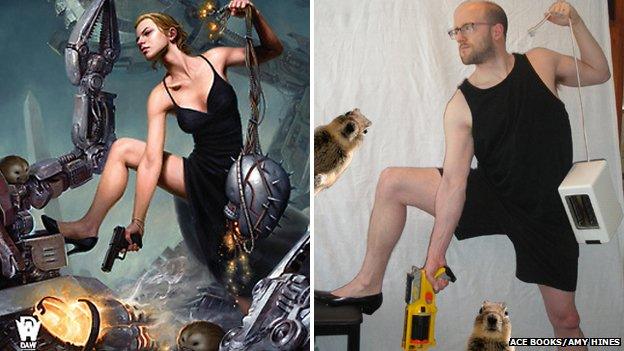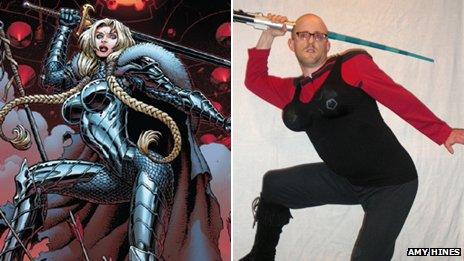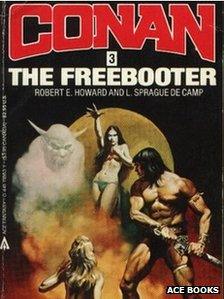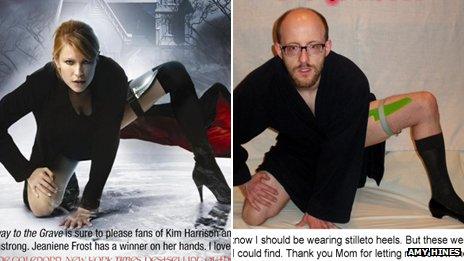The battle against 'sexist' sci-fi and fantasy book covers
- Published

A pose by fictional super-being exterminator Kitty Martini is recreated by Jim Hines
Science fiction and fantasy novels routinely portray scantily clad woman on their covers - a device that draws the heterosexual male eye but may turn away women readers. Lynsea Garrison finds one fantasy author aiming to zap gender stereotypes.
Jim Hines straddles the remnants of a defeated alien species (a table), and clasps a pistol (a toy gun) as he triumphantly raises a cyborg's head (a toaster). Sometimes he fights battles alongside his romantic interest (a large teddy bear).
But no matter the mission, Hines shows some flesh. Just because he is waging a war, it does not mean he cannot be alluring at the same time, right?
Hines, a fantasy author, is posing like some of the female characters on science fiction and fantasy book covers he says objectify women.
He gets into character by twisting his body into the same contorted positions as the female characters on the books.
"The way women are portrayed is just so ridiculous, so often, you just stop seeing it," Hines says.
"I think posing has made people see it again - you see how ridiculous it is when a 38-year-old fantasy writer is doing it."

Since he started in January 2012, Hines' poses have become the most popular posts on his blog. So he launched a new series in December to raise money to fight Aicardi syndrome, a genetic disorder that mostly affects girls.
The series has drawn more than 100,000 people to Hines' website and raised $15,405 (£9,623) for the cause.
The project is one of the latest expressions of a growing conversation about the portrayal of women in science fiction and fantasy cover art.

The Conan book covers popularised a now-common visual aesthetic
Tracy Hurley co-founded Prismatic Art Collection, a directory of artists who draw more diverse depictions of men and women in fantasy art, particularly for role playing games like Dungeons and Dragons.
"Women are so often portrayed assuming that a stereotypical hetero male is going to be the person looking at the cover," says Hurley.
"Male characters [are] powerful and strong, and women's sexuality will be emphasised. And why is that a problem? It's constraining for both men and women."
Many science fiction and fantasy readers are disappointed to encounter everyday sexism in a medium that is supposed to offer an escape.
Covers frequently exhibit women's bodies with revealing clothing unsuitable for combat, and fans argue that sexualising female characters sends a message to readers that women are sex objects.
Hurley says her goal is not to ban attractive women from book covers but to encourage publishers to include a wider variety of female characters.
"I worry about girls who don't see a character who looks like them and feel that science fiction and fantasy aren't for them," she says.
Part of the challenge is that women have long been portrayed on book covers in the same manner - thin, white and conventionally attractive.
The stories of Conan the Barbarian are largely credited with transforming fantasy art in the 1960s. These covers showcased muscled men and servile women, a style that artists replicated in subsequent decades.
When Irene Gallo began working in the publishing industry in the 1990s, publishers were moving away from the women emblematic of the Conan covers.
"Our sales people were saying that we want sexy women on covers, but we want them to be in active roles," says Gallo, now creative director of Tor Books.
Covers are improving, but strong women in chainmail bikinis and tight clothing regularly appear in comics and subgenres such as urban fantasy and paranormal romance.
While these women are supposed to be fighters, critics say they are drawn in a way that renders them powerless.
"People think that if you give the girl a gun, suddenly she's a strong woman," said Silvia Moreno-Garcia, a fantasy writer.
"But maybe she's still a sex object. We forget that the pose, the cropping, the way it's painted [all] tell a story. So if you have one element that says strength - like a gun - but everything else doesn't follow that, that's not the narrative you think you have."
Gallo thinks part of the problem is that male artists greatly outnumber female artists in the industry.
"You go to art school, and it's 50-50," Gallo said. "But professionally, it's overwhelmingly male.
"This is an unfortunate fact of the industry. These artists grew up with comics and gaming, so it's easy to perpetuate these things without thinking them through."
Marketing strategies may also be responsible for sexist covers. But the mantra that sex sells may not be accurate.
According to 2012 data from publishing industry analysts Codex Group, less overtly explicit covers in fact have a wider appeal among general readers.

Codex Chief Executive Officer Peter Hildick-Smith remains puzzled why science fiction and fantasy publishers sell sexualised covers.
"My guess is that it has simply evolved as category convention, allowing book buyers to instantly know that a given books is in one of their preferred categories," he said.
Hines, author of such titles as Libriomancer, The Mermaid's Madness and Goblin Quest, says many in the science fiction and fantasy community have not had to think about harmful messaging or sexism.
While momentum is building, Hines does not think the industry is at a tipping point yet. And that means readers will likely see covers he says objectify women for a while.
Hines is just trying to make sure his covers aren't among them.
"My next book has a woman on the cover," Hines says.
"And I told my publisher: 'if you put her into one of these spine-contorted poses, the entire internet is going to make fun of you.'"
You can follow the Magazine on Twitter, external and on Facebook, external